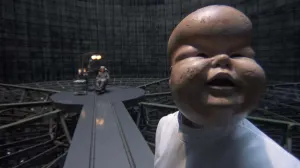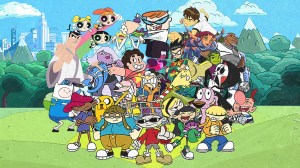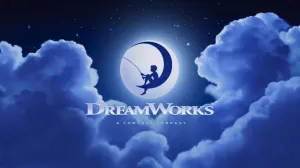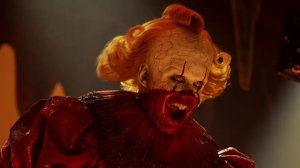March 31st marked the return of Young Justice: Phantoms, as the heroes of the DC Universe tackled a new crisis underseas. The fourth season of Young Justice has split its episodes into story arcs, allowing different casts of characters to get the spotlight. The most recent story arc featured heroes and villains of Atlantis, and the possibility of a prophecy coming true. Two of the creative minds behind the DC animated series are producers Greg Weisman and Brandon Vietti, who have been behind Young Justice since its inception in 2010.
Videos by ComicBook.com
ComicBook.com spoke to both Weisman and Vietti ahead of the Atlantis story arc concluding to discuss the series tackling real-world issues like death and grief, the return of cloning, Atlantis crowning a new leader, end-credit stingers, and the tie-in digital comic Young Justice: Targets.
The Weight of Responsibility on Kaldur
ComicBook.com: This season of Young Justice is juggling a lot of real-world issues, but death and grief appear to be front and center. Kaldur’s always been the adult in the room, but it’s obvious he’s suppressed a lot too. How would you describe his state of mind in this new story arc?
Greg Weisman: Kaldur’s definitely had to be the adult in the room, dating all the way back to the first season. He’s always the responsible one. The question we want to ask is, “When does the weight become too much? When is it overwhelming?” And that’s a lot of what this arc is about. At what point, given the history that we’ve explored with him, even the history that came before season one with him, of how he became the kind of person, as you said, the adult in the room. At what point does he stop and say, “I can’t carry these rocks any further?”
And that was a big part of what this arc was about for him, for us, for the writers, and everyone involved.
Real-World Issues
And we’ve also seen some other real-world issues tackled, such as gender identity, classism, and polyamorous relationships. When it came time to broach these topics, how did you decide which characters would best represent each dynamic?
Brandon Vietti: To some degree, the characters tell us. And we have obviously lots of history with the characters through comics and various media about the DC universe. And so we can, to a great degree, take a look at what’s been done.
In other cases, we have some rather unique stories for these individual characters, as we’ve carved out Earth-16 as a sort of unique place that doesn’t necessarily follow the exact same history as what we’ve seen published in comics. We have a lot of variations of course, through our timeline. And sometimes those variations will lead us to make certain choices about what kinds of issues might be appropriate for what individual characters.
So you’re right. We try to bring in many of those various issues for these characters to show them, how they deal with these things, how they grow through these things, how they learn, because that really is a goal of the show, is to grow the characters in a very relatable, realistic way that will resonate with our audience, and serve as a good counterpoint to a lot of the very fantastic adventures that we get to take our characters through in the vast DC universe.
Attack of the Clones
In this most recent episode, we have more clones coming back, which have played a role in the series in previous seasons. We saw Ocean Master and Arion, both were clones created by Vandal Savage. Without going into spoilers, what can you say about Vandal’s renewed interest in Atlantis?
Vietti: I don’t think it’s renewed interest. It’s ongoing, continuing interest. Just for the last 12,000 years only, he’s been interested in Atlantis. And I think it doesn’t mean that the audience has been aware of it, but he has. And so I think he set out to do something 12,000 years ago, and felt the job was only ever half done. And so he’s still striving to complete that goal from way back when, and with limited success ultimately.
But yeah, I think it’s been an ongoing concern of his, and it’s been fun this season to give a little context to Atlantis in the magic arc, the Zatanna arc last fall, and then to see the repercussions of that here in the Kaldur arc, the Atlantis arc. I think for me at least, that was a nice confluence of storytelling that we could prime the Atlantis arc back in the magic.
The New King of Atlantis
And during this arc, we see that Mera ends up taking on the title of King of Atlantis. What made her the perfect choice to take over for Orin, and why was now the time to mix things up on that front?
Weisman: We were I think consciously striving to do different genres with each arc, and this was our fantasy Game of Thrones arc. So we wanted to mix it up, and see again, as Brandon said earlier, the characters kind of tell us where they need to go. And it just became clear that Orin’s time as King was coming to an end and it was Mera’s time to step up and step forward, in that she was best qualified to do that.
It was also something that they did in the comics, that DC did in Aquaman comics, and Mera comics. So it all felt right. And it felt like the path the characters were leading us down.
Lords of Order Step Up
I want to go back to the clones for just a second. I guess to get some clarification on my end. When the Arion clone puts on the crown, and then it dissolves and explodes and turns to dust. Obviously that wasn’t Vandal’s plan. But was that a case of just the clone DNA not being able to withstand the power that comes with wearing the actual crown?
Vietti: No. I think that was about it not being Arion, and that’s who made the deal for the crown with the Lords of Order. And the Lords of Order knew it wasn’t Arion. And they were like, “Uh-uh, negative.” And that was hubris. In other words, they had no idea Vandal and the Arion clone. It was really Orin, had no idea that Kaldur was going to find that crown.
In one episode previous Arion says to Orin and Mera, “Forget about the crown. You’re never going to find it.” And then it’s a moment of hubris. The crown is found and the Arion clone says, “Okay, you found the crown, give it to me, belongs to me.” Shouldn’t have done it. And he is warned. It’s like, don’t do it. But he does it. And the Lords of Order do not like it. That was their crown.
End-Credits Stingers
That makes more sense now, when you put it that way. What was behind the thinking to give more depth to the stingers that run during each episodes end credits? Because I’ve really enjoyed them this season.
Vietti: We love coming up with those. They evolved from season three where I think it was a desire to do something more with the credits than just roll credits, and see if we could get a little more story or a little more emotional resonance into the credits and maybe have the audience stick around a little bit. I remember too actually, now that I think about it, some of the season three enders and credit scenes were so warm and fuzzy because we were dealing with some legitimately dark stories, and we just needed to lift the mood and end somewhere a little nicer on the way out. And as we evolved into our fourth season, I know we both wanted to tell more story there, use that time. Greg had a lot of great ideas for dialogue scenes that could happen to expand on some character stories that we may not have the screen time to delve into.
And in addition to that, there was just more thought put into emotional counterpoints to the story. Each credit sequence really ranges from warm and fuzzy, to comical, to very serious. And we really had to put some thought into, how do we end each episode? What just happened? Where did we leave the audience at the end of the story? What emotion do we want to convey during the credits as well as what extra story do we want to give?
So there was a lot of thought put into that by us, and we really enjoyed doing it because there’s the production challenge of having to make sure that we weren’t doing extra animation there. We had to keep it very limited because we didn’t want to subtract from the animation used for the body of the episode. So we had to be very economical about how we presented these stories during the end credits, but it was a challenge that we really got into and really enjoyed.








